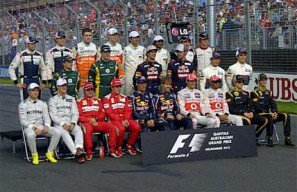Angry Carlos Sainz almost demands Oscar Piastri give back on-track spot after fierce battle
The Spanish driver claimed he was forced off the track while trying to overtake into fourth spot and wanted the McLaren driver to give…

Few periods in Formula One’s history can surpass the 1960s for drama, excitement and technical innovation.
At the beginning of the decade, front-engine cars were still common, yet by the time the Beatles split, the predecessor of modern Formula One design had been born.
When Ferrari and Brabham sported wings in 1968, a small part of Formula One and motor racing died. It signalled the end of the pioneering days of mechanical engineering, as the lines between motor sport and aeronautics became blurred. Today they are indistinguishable.
Modern Formula One cars look very much alike, deviations of the same basic shape and construction. There is little freedom for engineering expression like there was when Derek Gardner pencilled the Tyrrell P34. Innovation has become stagnant as regulations grow forever tighter, pioneers left to explore loopholes rather than pursue true experimentation.
As the sport grew up during the 1970’s its commercial value began to rise. Sponsorship was first allowed in 1968 when oil and tyre companies refused to supply their wares for free. Lotus broke tradition first and replaced its green and gold livery with the Gold Leaf cigarette insignia.
Bernie Ecclestone realised the sports potential first and grouped the teams to give them greater bargaining power. He negotiated commercial contracts which, as the years wore on, generated billions of dollars for the teams, the sport and naturally himself. He has created a great many millionaires in his time.
In doing so he also injected cash where once there was none. Jo Bonnier, the great Swiss driver of the 1960s, transported his car to the circuit on an open top trailer towed behind a station wagon. Frank Williams ran his team from a telephone box before he made it big. Formula One has not always had money like it has today.
Over the thirty years or so that followed Ecclestone’s arrival at the helm, the sport enjoyed a constant influx of cash. In 1978 Niki Lauda, then a double world champion, was paid $500,000 for his services, while Mario Andretti was the first driver to earn $1 million in 1980. Fernando Alonso earned a reported $40 million in 2010.
Inevitably as money came in, teams spent tn on development. With the fundamental mechanical components mastered, bigger gains were soon found in aerodynamics. Lotus, pioneers for much of the technology in Formula One, came across ground-effect and dominated the 1978 season.
But Colin Chapman, the team boss and lead designer, didn’t really understand it and was not able to hit home its advantage in 1979. Others did, including Williams, where a young Patrick Head had taken charge of car design.
By the early 1990’s aerodynamics were as critical as engine power. New regulations were introduced to slow down cars, outlawing turbo-charged engines and active suspension, refining aerodynamic regulations. It served only to divert money to other development streams.
To stand still in Formula One is to go backwards. Teams quickly regained lost ground, so more regulations were introduced. The merry dance has gone back and forth ever since, as engineers try to outsmart the rule makers.
Gone unchecked, engineers would have quickly made the sport unsustainable. Give a racing engineer a cheque book at your peril.
It has proved to be a prudent and justified approach when the global economy ground to a halt. The money that was once there dried up and teams have been forced to do without ever since.
They had agreed among themselves to reduce spending, under a Resource Restriction Agreement. It essentially gave the teams a figure which they were allowed to spend on development and headcount. More in one meant less in the other, though there were significant areas not covered, and it ultimately proved to be more trouble than it was worth.
Costs are an issue, and it is only tight regulatory restrictions which keep some of the teams afloat. Should the gates be opened, the likes of Red Bull and Ferrari, who have very deep pockets, could no doubt make their cars faster.
Active suspension, ground effect, traction control, pit to car telemetry – the sort of stuff which Joe Public has little to no knowledge or understanding of from the grandstand, would soon put the likes of HRT, Marussia and Caterham out of business. I wouldn’t want to be in charge at Sauber or Force India, for that matter, once the big boys turned Formula One into a spending race.
By keeping regulations restrictive and stable, cars will look the same as designers hone in on the ideal solution. But it also keeps the sport alive. With the teams bickering like schoolchildren, Formula One needs a firm and steady hand to guide it, and while we may question the FIA at times, the governing body does have the sport’s best interests at heart.
That is why stable engine regulations and in-season testing restrictions are good for the sport. The days of spending the millions of others on whimsical developments is gone, and it’s time Formula One began to mature in the way it handles money.
Formula One was the pinnacle of motor racing when Jo Bonnier towed his car to the Nurburgring, and it remains so today. Do I care if teams spent $250 million or $25 million to produce that spectacle? Not in the slightest, so long as the sport is competitive and relevant.
In this day and age that means checking spending as the rest of us are doing.
What do you think? Will cutting costs and tightening technical regulations be the way to protect Formula One’s future?